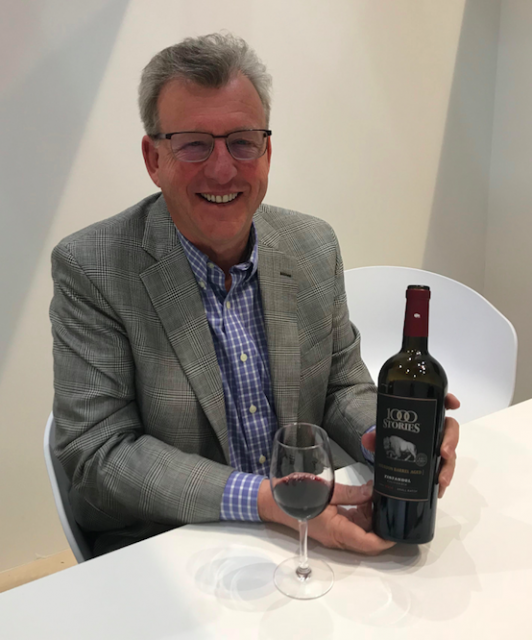This website uses cookies so that we can provide you with the best user experience possible. Cookie information is stored in your browser and performs functions such as recognising you when you return to our website and helping our team to understand which sections of the website you find most interesting and useful.
Inventive winemaker and green champion Bob Blue to retire
Bob Blue, the founding winemaker for Californian organic wine brand Bonterra, and inventor of Bourbon-barrel aged wine, is set to retire next month.

Blue, aged 66, who is currently director of winemaking at Fetzer Vineyards, which owns Bonterra, is “officially retiring” on 10 June, after an extended handover period to John Kane, who is vice president of winemaking at the Californian winery, having joined the business in 2016, following a long career at Rosenblum Cellars.
Speaking at a dinner in London last night to celebrate the career of Blue, James Hick, who is commercial manager at Fetzer parent company Concha y Toro, paid tribute to the winemaker, describing him as a “pioneer” and the “founder of the original, and most highly-awarded Bourbon barrel aged wine: 1000 Stories”.
When Blue leaves Fetzer next month, he will have served 34 years at the company, and completed 39 harvests during his career – 40 if you include one spent picking pears.
With his first harvest in the wine industry being 1982, he said he had seen significant change in the Californian wine scene, commenting that it has “been incredible to ride the wave”.
Aside from his unrelenting dedication to organic and sustainable viticulture, which gained him the Lifetime Achievement Award in The Drinks Business Green Awards 2014, Blue can be credited for creating an entirely new and successful category of wine.
As previously reported by db, Blue was the first winemaker this century to take a Californian Zinfandel, age it in Bourbon barrels, and then release it in the US under an entirely new brand – 1000 Stories – having achieved the necessary legal approval for wine first.
Having launched it with 5,000 cases in 2014, the brand is now on course to shift almost 200,000 cases annually worldwide, and includes a Chardonnay and Cabernet Sauvignon too, while spawning many imitators.
Indeed, not only are there now a raft of Bourbon barrel aged wines, but also other finishes, from Merlot in rum barrels (Robert Mondavi) to Sauvignon Blanc in Tequila casks (Beringer Brothers).
In an interview with Blue during the international launch of 1000 Stories at ProWein in 2018, he said that the idea for the wine came about when discussing target markets and trending products in the drinks industry.
“We were talking about new projects and, having noticed that there were wines for women, we thought, how about a wine for guys? And what about using Bourbon barrels? – Because, as a franchise, Bourbon is really growing,” he recalled.
Blue then said that when he started making wine in 1982 it was actually fairly common in California to buy ex-Bourbon barrels for finishing wine – pointing out that it was only the small family-owned wineries like Mondavi and Montelena that were using French oak.
Not only that, but he remembered tasting extremely ripe styles of red during his youth – a type of wine that suited well the sweet flavours of American oak, and particularly those formerly used to age US whiskey.
“I remember the Zins in the late 70s, which were big wines made by picking really ripe grapes, so they were like Amarone on the vine, with some stuck ferments [to leave some residual sugar in the wine] which were then finished in Bourbon barrels,” he said.
As a result, when the team at Fetzer suggested in this decade the idea to age a wine in Bourbon barrels, Blue was able to tell them that he had already experienced this.
He also said that Bourbon producers were using ex-winery barrels to finish their spirits – such as Woodford Reserve, which use used Pinot Noir barrels from Sonoma-Cutrer – so it seemed apt to do the opposite and use the use casks from the spirits industry for finishing wines.
Wine laws in the US did, initially, prohibit wine producers from mentioning the use of barrels from the spirits industry on their labels, but Blue said that due to the craft beer movement, where different finishes have become commonplace, “the lines have been blurred, and the door has been opened, so we were able to get our label approved” – which clearly states that this wine uses Bourbon barrels.
He also assured db that Fetzer was the first to use Bourbon barrels in winemaking in the modern era of the Californian wine industry.
Once retired, Blue told db yesterday that he plans to stay in touch with his peers in the drinks industry by judging in wine competitions, while he hopes to travel more widely, and play more table tennis, having bought a robot to play against.
Blue, who grew up in a family of tee-totalers in Lake County, California, discovered wine when travelling through Germany as a young man, having been posted there as a GI – he had joined the army after high school.
After graduating from UC-Davis, Blue joined Mendocino County’s McDowell Valley Vineyards in 1982, before taking on a role at Fetzer Vineyards in 1988, where he was mentored by legendary California winemakers Paul Dolan and Dennis Martin.
Related news
Groupe Bollinger appoints new deputy CEO

